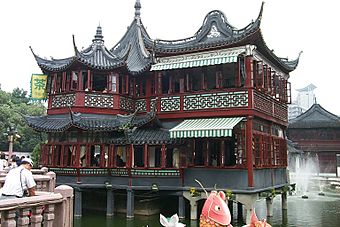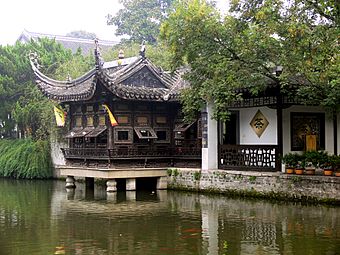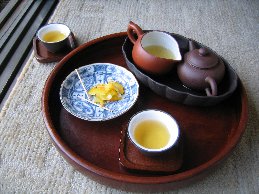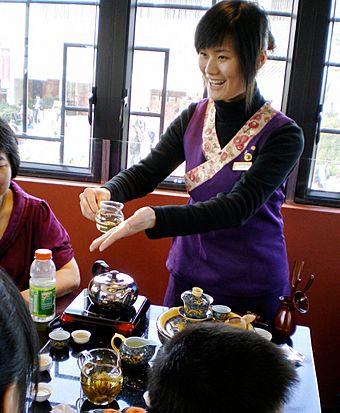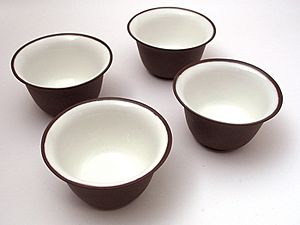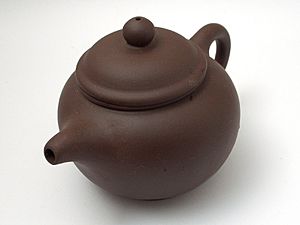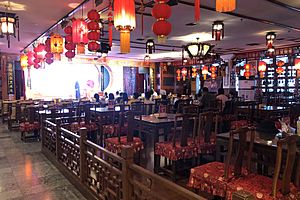Chinese tea culture facts for kids
Quick facts for kids Chinese tea culture |
|||||||
|---|---|---|---|---|---|---|---|
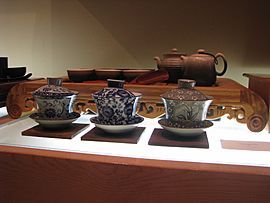
Chinese tea sets
|
|||||||
| Traditional Chinese | 中國茶文化 | ||||||
| Simplified Chinese | 中国茶文化 | ||||||
|
|||||||
| Alternative Chinese name | |||||||
| Traditional Chinese | 茶藝 | ||||||
| Simplified Chinese | 茶艺 | ||||||
|
|||||||
| Second alternative Chinese name | |||||||
| Traditional Chinese | 茶道 | ||||||
| Simplified Chinese | 茶道 | ||||||
|
|||||||
| Third alternative Chinese name | |||||||
| Traditional Chinese | 茶禮 | ||||||
| Simplified Chinese | 茶礼 | ||||||
|
|||||||
Chinese tea culture (zhōngguó chá wénhuà) is all about tea in China, from how it's grown and made to how it's enjoyed. It includes the history of tea, how people brew and serve it, and the special ceremonies. Tea culture also has deeper meanings, like its role in symbols, spirituality, and social life. Tea has been a part of China for over 4,000 years and is still very important today. It has shaped many parts of Chinese life, like customs, art, and daily habits.
China's tea culture influenced countries like Japan and Korea a long time ago. These countries developed their own tea ceremonies, but they are still quite similar to China's. Other countries, like the United Kingdom and United States, adopted tea later and have very different ways of preparing and drinking it. In modern China, tea is still a popular drink for both everyday moments and special events. It's also used in traditional Chinese medicine and cooking.
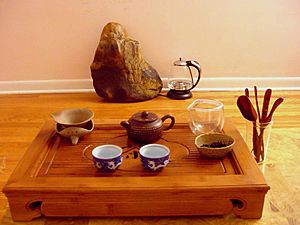
Contents
What is Chinese Tea Culture?
In Chinese, the idea of "tea culture" is called chayi ("the art of drinking tea") or cha wenhua ("tea culture"). The word cha (茶) means the drink that comes from the tea plant. Before the 8th century BCE, tea was called tú (荼), which also meant other bitter plants. The Chinese character for tea (茶) is very similar to the older character for tú, with just one small difference.
A Quick Look at Tea History
Tea was first found in southwest China more than 4,000 years ago. Many people believe that Shennong, who is known as the father of medicine and farming, discovered tea. He was famous for tasting many plants to see if they were food or medicine.
One story says that Shennong had a see-through stomach. He could watch how his body reacted to what he ate. One day, while boiling water, some leaves fell in. He drank the water, found it sweet, and felt more energetic.
Another story says Shennong tasted 72 poisonous leaves and became very sick. Some leaves fell near him, and he chewed them. He quickly felt better and more energized, and the poison left his body. The first book about tea's medical effects was the Shen Nong Herbal. People in ancient China likely ate tea leaves, but tea became a cultural activity over a long time.
Early Dynasties: Tea for the Elite
- Zhou Dynasty (1046-256 BC): At first, tea was a luxury for nobles and royalty. They drank it to feel energized and clear their minds. Tea was often boiled with other plants to make a "tea soup." This soup was a mix of medicine, food, and drink. It was often bitter, so it wasn't popular with everyone. Tea ceremonies were also part of religious rituals.
- Han Dynasty (206 BC-AD 220): During this time, people got better at picking and preparing wild tea. This made tea taste better, and it became a refreshing drink for nobles.
- Jin Dynasty (265-420) and Wei Period (220-265): Tea culture mostly grew among the upper class, like scholars, monks, and officials. Tea was seen as a good drink, unlike wine, which was linked to being wild. Tea was linked to "freshness and purity." It became part of deep talks about philosophy and religious ideas for Buddhists and Taoists. Buddhists thought tea helped them stay awake, and Taoists believed it could keep people young. Before the Tang Dynasty, tea was mainly for the rich, used for medicine, offerings, or ceremonies. Most people didn't enjoy it for fun.
Tang Dynasty: Tea Spreads Wide
During the Tang Dynasty (618-906), tea culture became very popular across China. A new way of processing tea, called 'green stemming', made it taste even better. Trade routes like the Ancient Tea Horse Road helped move tea from southern China to other areas like Tibet. The Grand Canal also made it cheaper to transport goods, including tea. These changes helped tea become a national drink.
Artists created many tea-related works, like poems, drawings, and songs. Tea houses and tea shops also opened up.
A very important book, The Classic of Tea (780), was written by a tea expert named Lu Yu. This was the first detailed book about tea. It covered everything from tea's history and how to grow it, to how to prepare, serve, and drink it. Lu Yu also explained Chinese tea culture. He even suggested ways for common people to enjoy tea without expensive tools. Because of his huge influence, Lu Yu is known as the 'Sage of Tea' or 'God of Tea'. His book connected tea drinking to spiritual ideas, art, and Chinese philosophy. It helped turn tea from just a drink into an important part of Chinese culture.
Song Dynasty: Tea Flourishes
Tea culture truly blossomed during the Song Dynasty (960-1279). Tea art, ceremonies, and tea houses became even more popular. Being good at things like the game of Go, playing the zither, calligraphy, painting, and writing poetry were seen as polite skills for gentlemen. Many books about tea were written, including Record of Tea by Cai Xiang and General Remarks on Tea by Emperor Huizong.
China used its control over tea as a powerful tool in diplomacy. They set up 'Tea and Horse Offices' to trade tea for horses with Tibet and other regions. These horses were needed for battles. If there were problems, the government would threaten to stop the tea trade.
Tea culture became more complex for the rich, with many new rules. But it also spread to more people. Tea farming became common, and Chinese tea was traded all over the world. 'Tribute tea' was high-quality tea given to the emperor as a gift. This became a big system, with officials managing tea farms and transport. These officials often wrote poems about their experiences and the tea harvesting process.
Tea in the 20th and 21st Centuries
Tea became a global product. However, under Mao Zedong's rule (1949-1976), China was mostly cut off from global markets. In the 1960s, during the Great Leap Forward, tea production was limited, and many tea houses closed. The Cultural Revolution also harmed China's tea culture.
Later, under Deng Xiaoping, China's economy grew quickly. This led to a rebirth of the tea industry and traditional tea culture. China is now the top producer of tea again.
Today, you can experience Chinese tea culture in many ways, like visiting museums, tea trails, tea houses, and tea markets. There's a National Tea Museum in Hangzhou, China, and another in Taiwan. New, stylish tea houses are also opening, attracting young people in cities.
Chinese Tea Ceremony
The tea ceremony, or 'Cha Dao' (茶道), is a special Chinese activity for preparing and serving tea. It has been very important in China for over a thousand years. The idea of "ceremony" (Li, 礼) is a basic part of Chinese culture.
The tea ceremony became popular in the Tang Dynasty and reached its peak in the Song Dynasty. The main steps include: preparing the tea, serving it, admiring its look, smelling it, and then slowly drinking and tasting it.
For a good tea ceremony, you need high-quality tea and excellent water. The best water is 'Tiashui', which is rain or snow water. Natural spring water is also good. Lu Yu even listed 20 different levels of water quality. Beautiful tea sets are also important to enjoy the tea's smell. The book The Classic of Tea described 24 different tea tools.
The place where tea is served also matters. Tea is special if enjoyed on misty hills, with cool breezes, or under moonlight. Chinese culture emphasizes harmony between people and nature when drinking tea. During the Ming dynasty, there were rules about when and where to drink tea. You should be relaxed and in a peaceful place, like a courtyard or a forest. The weather should be nice, maybe rainy or moderately sunny. Tea should be enjoyed in a calm setting, not a noisy one, and usually with only a few people. As Cai Xiang wrote in his book A Record of Tea (1051), "The fewer guests when drinking tea, the better."
People believe that drinking tea is a spiritual pleasure, an art, and a way to improve oneself. The tea ceremony is a tradition that shows Chinese culture and has spread worldwide.
Tea Competitions
Tea competitions started in the Tang Dynasty and became very popular during the Song Dynasty. These events were high-level tea-tasting contests. Contestants, usually men in the imperial palace, would show off their best tea. Emperor Song Huizong loved these competitions. The quality of the tea, the tools used, and the water were all very important to win.
This game was called 'fighting tea' (doucha) or 'tea war' (mingzhan). The competition involved the whole process of making tea. A key part was whipping the tea. The tea was stirred strongly with a wooden whisk to create a foam on top called 'Tanghua'. This foam was made by pouring boiling water over the tea leaves and beating the water. This process could be repeated up to seven times. If the tea could be seen through the foam, the competitor would lose. Being good at whipping up bubbles showed refinement. Winning a tea competition was a way for men to show their skill and status.
Tea Arts
During the Tang and Song Dynasties, scholars created poetry, calligraphy, and paintings to show their educated minds. They were also big tea drinkers. Talented tea drinkers connected tea drinking with other refined activities like art, music, and literature. Lu Yu, who wrote The Classic of Tea, was also a poet and calligrapher.
Here's a small part of a famous tea poem from the 8th century:
The first bowl sleekly moistened throat and lips;
The second banished all my loneliness;
The third expelled the dullness from my mind,
Sharpening inspiration gained from all the books I've read.
The fourth brought forth light perspiration,
Dispersing a lifetime's troubles through my pores.
The fifth bowl cleansed ev'ry atom of my being.
The sixth has made me kin to the Immortals.
The seventh is the utmost I can drink
This poem was a thank you note from Lu Yu after receiving tea as a gift. Giving tea as a gift was common. Often, artists would send a poem with the tea, and the person receiving it would send another poem with a return gift. This led to the term 'benevolent tea' (huicha).
Writing poetry was very popular during the Tang and Song Dynasties. It was a must-have skill for scholarly men. Many poems from these times are about tea. Famous writers like Su Shi wrote enthusiastically about tea.
Calligraphy was another popular art form where tea culture was included. Some calligraphy masterpieces from this time are about tea. For example, a casual note from Su Shi inviting a friend to tea is now a famous art treasure.
Tea Drinking Customs
Tea customs change depending on the people, regions, and beliefs. Chinese tea arts include Confucian tea, Taoist tea, Buddhist tea, and "vulgar tea" (tea for the public). Each follows different moral and behavior standards. Taoists see tea drinking as a way to improve body and soul. Buddhists believe it helps them understand Zen. Confucians use tea for hospitality, showing their humanistic views.
China's many minority cultures also have their own tea customs. For example, Tibetans value tea highly. A gift of brick tea is very special. They serve butter tea to important guests and salt tea to regular guests. Mongolian herdsmen drink milk tea. If you visit, you'll be offered tea, and not accepting it would be very rude.
There are several special times when tea is prepared and drunk in Chinese culture. These customs are still followed in Mainland China and Taiwan.
A Sign of Hospitality
Being welcoming is important in Chinese culture. Offering tea to a guest is a common practice. Guests are expected to accept the tea and take at least a sip to show thanks.
A Sign of Respect
Younger people show respect to older family members by offering them tea. Inviting elders to restaurants for tea is a traditional holiday activity. Newly married couples serve tea to their older family members. In the past, people of lower social class served tea to the upper class, but this rule is less strict today.
To Apologize
In Chinese culture, tea can be offered as part of a formal apology. For example, children who have misbehaved might serve tea to their parents to show they are sorry.
To Show Gratitude and Celebrate Weddings
In a traditional Chinese wedding ceremony, the bride and groom kneel before their parents and older relatives. They serve them tea and thank them. This shows their gratitude and respect. This act also symbolizes the joining of the two families.
Finger Tapping
Light finger tapping is an informal way to thank the person serving tea. After your cup is filled, you can tap your index and middle fingers (or other combinations) on the table. This shows thanks to the person who served the tea. This custom is common in southern China, where many servings of tea are part of meals.
This custom is said to have started during the Qing dynasty. The Qianlong Emperor traveled in disguise, and his servants were told not to reveal who he was. One day, the emperor poured tea for a servant. It was a huge honor for the servant to have the emperor pour tea for him. He wanted to kneel and bow to say thank you, but he couldn't, as it would reveal the emperor's identity. Instead, he tapped the table with bent fingers. This was a way to show he was kneeling and thanking the emperor. In formal tea ceremonies, nodding your head or saying "thank you" is more proper.
Brewing Chinese Tea
The way Chinese tea is brewed depends on how formal the occasion is, what tools people have, and the type of tea. For example, green teas are more delicate than oolong or black teas, so they need cooler water. The simplest way to brew tea is to just add leaves to hot water in a pot. This is common in homes and restaurants, like when you have dim sum. Another way is to use a small lidded bowl called a gaiwan. The Hongwu Emperor of the Ming dynasty helped make loose tea brewing popular by banning the making of pressed tea cakes.
Gongfu Cha (Kung Fu Tea)
Gongfu cha means "making tea with skill." It's a popular tea ceremony method in China. It uses small Yixing teapots, usually holding about 100–150 ml. This size is thought to make the tea taste better. Small tea cups are used with these teapots. Gongfu tea is often enjoyed after a meal to help with digestion. You can brew tea this way for yourself or to welcome guests. The steps and tools might be a bit different depending on the region in China. For example, Taiwanese gongfu cha uses extra tools like tweezers and a tea strainer. This method is mostly used for oolong teas, but also for pu'er and other fermented teas.
Tea's Influence on Chinese Culture
Since the Tang Dynasty, drinking tea has been an important part of self-improvement. Chinese Chan (like Japanese Zen) philosophy is also connected to tea drinking.
Teaware
Traditionally, tea drinkers were seen as the "academic" and "cultural elites." Drinking tea showed a person's morality, education, and social status. The price of teaware can vary a lot, from hundreds of thousands of dollars for jade sets to less than a hundred for simpler ones. As more people became interested in tea, more teaware was made, which helped make Chinese porcelain culture very popular.
Teahouse
Ancient Chinese scholars used teahouses to share ideas. In a teahouse, people were said to set aside their political views and social rank to have honest talks. Drinking tea in a relaxed way encouraged friendliness and good manners. Teahouses are not just a small part of tea culture; they show a lot about Chinese tea history. Today, you can still feel a special atmosphere in places like Beijing's Lao She Teahouse and other teahouses in East China cities.
Modern Culture
In modern China, almost every home has tea tools for brewing hot tea. These are symbols of welcome for visitors. Traditionally, a visitor to a Chinese home is expected to sit down and drink tea while talking. Standing while visiting is considered impolite. Folding napkins in tea ceremonies is a traditional act in China to keep away bad energy. In Taiwan, tea ceremonies happen in daily life and for important events.
Tea was considered one of the seven daily necessities, along with firewood, rice, oil, salt, soy sauce, and vinegar. There are many types of tea, such as green tea, oolong tea, red tea, black tea, white tea, yellow tea, pu'er tea, and flower tea. Traditionally, fresh tea leaves are regularly turned in a deep bowl. This helps the leaves dry in a way that keeps their full flavor.
See also
 In Spanish: Cultura china del té para niños
In Spanish: Cultura china del té para niños


